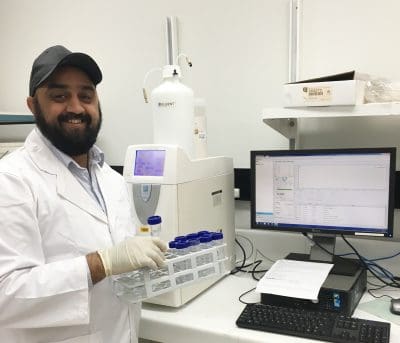MANAGING stubble as a nutrient bank in rotations can improved nutrient availability in soil for following crops, according to the latest results from a Grains Research and Development Corporation (GRDC) funded research project.

NSW DPI researcher Dr BP Singh says light tillage, when used strategically, could benefit productivity of crop rotations through increased coupling of soil carbon and nitrogen cycling and provide opportunities for management of heavy stubble loads. (Photo: NSW DPI)
NSW Department of Primary Industries (DPI) scientist, Bhupinder Pal Singh, has been monitoring soil organic carbon and nutrient levels under different management practices and soil types.
Dr Singh and his team completed laboratory trials, simulating mixing wheat and canola stubble residues with soil.
The trials showed an effective tillage strategy, such as incorporating stubble to a shallow soil depth (five to 10 centimetres), caused a distinct increase in plant available nutrient levels for nitrogen, phosphorus, and sulphur over a four-month breakdown period of stubble residues, under ideal soil moisture and temperature conditions.
However, these same nutrients may also be locked up in the soil profile and immobilised by soil microorganisms in the shorter term, rendering them temporarily less available for plant root uptake.
“Stubble incorporation by tillage to a shallow soil depth may not increase nitrogen availability, relative to phosphorus and sulphur availability. This is likely due to greater microbial immobilisation of nitrogen than phosphorus and sulphur,” Dr Singh said.
“However, there can be a considerable increase in crop nutrient release in the stubble incorporated soil over the longer term.
“The level of nutrient release of nitrogen, phosphorus and sulphur can vary depending on the interaction of soil minerals, microbial activity, stubble residue type and soil type.”
Dr Singh said paddock trials were now needed to validate the research.
“The benefit of crop nutrient release may not be seen under real paddock conditions until the second or third crop following strategic tillage of stubble late in the fallow, just prior to sowing,” he said.
Retaining stubble cover over the fallow is known to protect the soil from erosion, and light tillage which mixes stubble with the soil, just prior to sowing, will benefit soil nutrient availability for crop uptake, particularly phosphorus and sulphur, according to Dr Singh’s research.
Mobilising crop nutrients in the soil bank
Incorporating stubble into the soil releases mineral and organic bound crop nutrients from the soil bank following significant decay of crop residues.
Dr Singh’s work suggested that simple organic molecules may be released during residue decomposition over a four-month period, which may help mobilise crop nutrients bound to the mineral fraction of the soil, especially phosphorus, and to a lesser extent sulphur.
Strategic residue and tillage management can increase this rate of decay, potentially releasing crop nutrients from the soil reserves for plant uptake by following crops.
The effect of residue breakdown on phosphorus and sulphur release was greater in a cracking clay soil than a red sandy clay loam soil.
The stubble type also affected the rate of residue breakdown – incorporated canola stubble in the soils increased nutrient release more than wheat stubble.
Soil phosphorus stratification
Dr Singh also suggested incorporating stubble residue through light tillage may potentially enable release of immobilised soil phosphorus, held by the mineral component of the soil.
“Strategic tillage and stubble incorporation (to 10 centimetres) may dilute the surface stratification layers of phosphorus, relative to zero till,” he said.
Crop root residues
Dr Singh is also researching the effect of shallow tillage and nitrogen fertilisation on below ground root carbon inputs, soil organic carbon levels and crop nitrogen uptake at a field scale.
“The level of carbon input from the roots correlates strongly with crop nitrogen uptake and seed yield,” he said.
“Light tillage increased root growth, root carbon input, microbial activity and crop nitrogen uptake. These processes correlated well with seed yield, with potential to increase soil organic carbon levels.
“We don’t know yet if soil organic carbon levels will go up, but strategic tillage and stubble management such as through light tillage operations may increase root carbon inputs and availability of crop nutrients, including nitrogen, phosphorus and sulphur, in the soil.
Dr Singh said light tillage, when used strategically, could benefit productivity of crop rotations through increased coupling of soil carbon and nitrogen cycling and provide opportunities for management of heavy stubble loads.
Source: GRDC



HAVE YOUR SAY